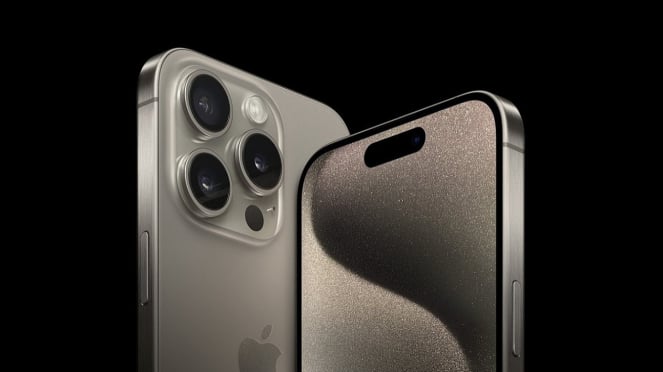6 Apple Features that Similar to Android
- Engadget
Jakarta – The iPhone 15 Series has finally rolled out and there are some amazing upgrades on offer. But, more than a couple of these upgrades are not exactly original. Apple and Android OEMs are no strangers to copying from each other, after all.
Therefore, here are six features in iPhone 15 that similar to Android, as sourced by Android Authority.
1. Action Button
The mute switch has long been a fixture on the iPhone line, but that changes with the iPhone 15 Pro series. The new phones offer an action button that can be remapped to your desired function or app.
Hardware shortcut buttons have been around for years on Android phones, with the likes of Samsung and BlackBerry offering programmable keys in the late 2010s.
We don’t see them much nowadays, but phones like the Nokia XR21 and Samsung’s rugged phones continue to offer the option.
2. Folded-zoom Cameras
Warna baru iPhone 15.
- 9to5Mac
The most notable iPhone 15 Pro Max camera upgrade is the 5x folded-zoom camera, which works using most of the same principles as folded-zoom periscope cameras.
In saying so, Apple’s execution differs somewhat from Android OEMs in that the camera sensor still faces outwards instead of sideways.
So it’s not quite a periscope design, but it still uses prisms to reflect light to enable Apple’s 5x zoom, much like all other Android periscope cameras out there.
amsung’s Ultra devices are still among the best camera phones thanks to a 10x 10MP periscope camera and 3x 10MP tele lens. However, we’re guessing that the iPhone will offer competitive or possibly even superior results at 5x.
While we’re talking about cameras, Apple also borrows a UI feature from Google and Samsung when you zoom in. More specifically, the iPhone now displays an overlay window that shows off the entire scene as the 1x camera sees it.
3. Refocusing
This is something we’ve seen on rival phones for years now, though. It actually debuted on the Nokia Lumia series first back in 2013 via the Refocus app, while 2014’s HTC One M8 offered this feature thanks to a rear depth sensor.
But phones from the likes of HUAWEI (wide aperture mode), LG (Magic Focus), Samsung (Selective Focus), and more have offered this option over the years.
We have seen some Android brands drop this feature since then, and early takes on this feature did result in a very synthetic look. So we hope Apple offers a more polished take.
4. USB-C
Apple has finally switched to USB-C on its iPhones, almost seven years after the first Android phones shipped with the port.
The standard iPhone 15 models offer slow USB 2.0 speeds, in line with low-end and mid-range Android phones. But the Pro devices deliver USB 3 speeds, broadly in line with Google and Samsung flagships.
This is one feature we’re glad the company has copied, even if it was forced to do so by the EU.
It means that you just need one cable for all your modern gadgets, while also opening the door for an entire ecosystem of accessories (from flash drives to SSDs and more).
5. Portraits After the Fact
iPhone 15 Pro Max.
- Apple
Apple touted the rather nifty ability to go back to captured photos and turn them into portrait shots. But again, this isn’t anything new for Android phones.
Google Photos offers the ability to turn old photos into portraits through a blur background suggestion or portrait tool.
Google Photos offers a “blur background” suggestion for specific shots (e.g snaps of people with a well-defined background), as well as a dedicated portrait tool in the editing suite.
These tools work offline too, so you don’t need an internet connection to turn your existing snaps into portrait shots.
6. AV1 Decode and Ray Tracing
Apple’s A17 Pro chip is looking like a super-powerful smartphone processor. But Apple is also offering a couple of chip-related features we’ve seen on Android phones for a while now.
Even the iPhone 15 Pro line's chipset is bringing two hardware features that first appeared on Android.
For one, it’s now offering AV1 decoding on the Pro phones. This allows for the same video playback quality at a smaller file size or improved quality for the same file size. Loads of recent Android phones offer this feature, and Netflix and YouTube offer AV1 streaming too.
In fact, 2019’s MediaTek Dimensity 1000 was the first smartphone processor to offer AV1 decoding.
Meanwhile, Apple’s Pro phones also bring ray tracing to the table. This technology enables more realistic lighting, shadows, and reflections in video games.
Last year’s Samsung Exynos 2200 chip (used in the European Galaxy S22 series) was the first mobile SoC to offer hardware-enabled ray tracing. But we’ve since seen the tech arrive on the Snapdragon 8 Gen 2 and MediaTek Dimensity 9200 processors.





























